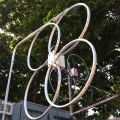G8JNJ
About
- Username
- G8JNJ
- Joined
- Visits
- 4,661
- Last Active
- Roles
- Member
- Points
- 130
Reactions
-
Kiwi not coming up after update (remote site) [fixed with software reload, root cause unknown]
Whilst messing about with my Broken Beagles I noticed that the DC volts at the power supply had to be at around 5.4V to provide 5v at the Beagle.
On first inspection this seems to be associated with the RF filter on the DC input of the KiWi board, which is causing a voltage drop to occur (before it is passed to the Beagle) when the KiWi is drawing it's approx 600mA average running current.
Further experimentation is required to find the optimum input voltage in order to ensure a clean start up.
I'd suggest checking the DC volts on the Beagle header when it's up and running, to see what's actually being applied to the board.
Regards,
Martin - G8JNJ -
Kiwi not coming up after update (remote site) [fixed with software reload, root cause unknown]
Whilst messing about with my Broken Beagles I noticed that the DC volts at the power supply had to be at around 5.4V to provide 5v at the Beagle.
On first inspection this seems to be associated with the RF filter on the DC input of the KiWi board, which is causing a voltage drop to occur (before it is passed to the Beagle) when the KiWi is drawing it's approx 600mA average running current.
Further experimentation is required to find the optimum input voltage in order to ensure a clean start up.
I'd suggest checking the DC volts on the Beagle header when it's up and running, to see what's actually being applied to the board.
Regards,
Martin - G8JNJ -
Broken Beagles
Hi Stu,
I agree you have to be careful with ESD paths, especially if you have big external antennas and live on top of a hill :-)
The first KiWi was obviously connected to the antenna etc. when it failed. However the second one only had the ethernet and DC connectors plugged in when it broke.
I have taken great care to ensure that the RF ground on the antenna and mains / DC supply ground are all at the same potential, including adding supplementary ground rods and suitable bonding cables.
My KiWi's have a spark gap (GSD), ESD discharge, 30MHz LPF filter, BC band notches, RF limiter and transformer isolation. All contained in a custom built module that I use to provide additional protection on the RF input.
You also have to be careful with DC supplies (especially the double insulated Switched Mode types - the ones with only a two core mains cable). These often contain an RF filter network consisting of a Y capacitor network across the incoming AC supply and to the supply ground, which is also often the DC ground. The net result is that the DC ground 'sits' at 1/2 AC supply potential (but at very low current).
However when you first plug in the DC connector to any kit that already has a ground return path, an appreciable current can flow from the Y capacitors to the ground of the kit the supply is being connected to for a fraction of a second. This can be enough to pop any sensitive devices.
I always make sure any DC supplies have a proper connection between the AC ground and DC ground to try and prevent this problem. However this can result in additional RF interference unless the RF, AC and DC grounds are all at the same RF potential (not the same as supply potential) or are isolated by means of RF choke baluns (or a combination of both).
It takes a lot of effort to try and maintain safety and ESD protection whilst at the same time trying to minimise RF interference paths. If you also have UPS's in circuit it becomes even harder :-(
I think my second KiWi popped when I was repeatedly plugging and unplugging the network cable whilst trying out different tests. I can only think that I must somehow have cross connected some of the pins or got the screen of the RJ45 shorted against something it shouldn't have.
Regards,
Martin - G8JNJ -
Broken Beagles
Hi Ron,
Swapping cables and such like was the first thing I tried.
Unfortunately it looks like the LAN8710A chips on both Beagle boards are fried.
I'm not sure what has happened. The first board was definitely not my doing, but the second could have been whilst I was swapping cables and boards around. Either way, I think it would be hard to pin the failure on Seeed after they have been running OK for this length of time.
At least I've been able to confirm that the KiWi boards still work, which was my main concern, so that's good news.
I've ordered up another couple of BBG boards to quickly get me up and running again (I had just ordered some metal cases prior to the failure, so I've held off from buying BBB's in case they are not compatible) and also a few LAN8710A chips to see if I can repair the existing BBG boards and keep them as backups, as I've nothing to loose if I mess them up during the rework process.
I was thinking that if I get the old BBG's working again I could just buy some KiWi boards to use with them. But actually it seems that it's probably cheaper to wait and get a whole kit via Massdrop than buying just the KiWi boards from Seeed.
Fingers crossed that I can get it all up and running again without too much hassle :-)
Regards,
Martin - G8JNJ -
OpenWebRX [using a transverter/down-converter with the Kiwi]




